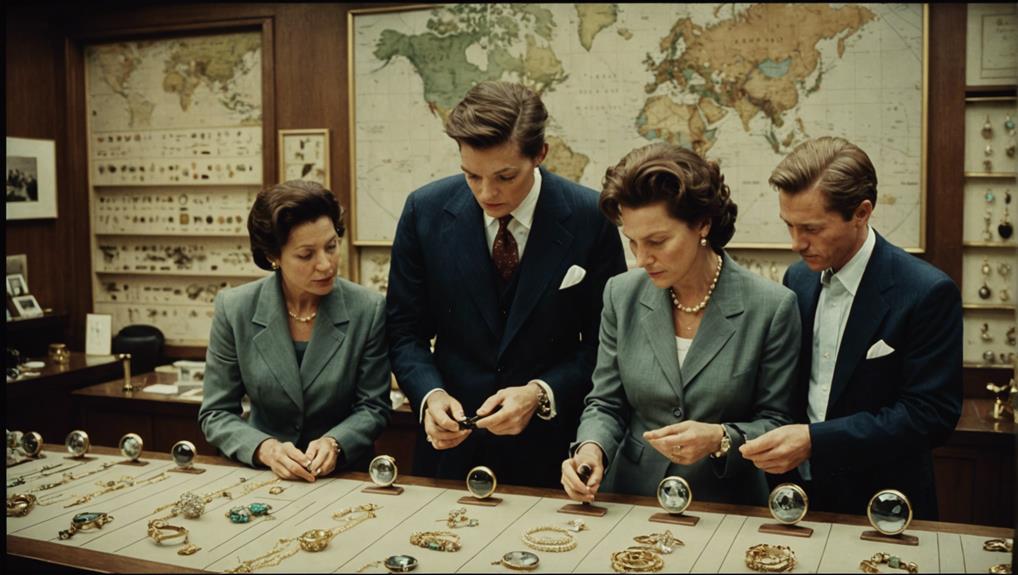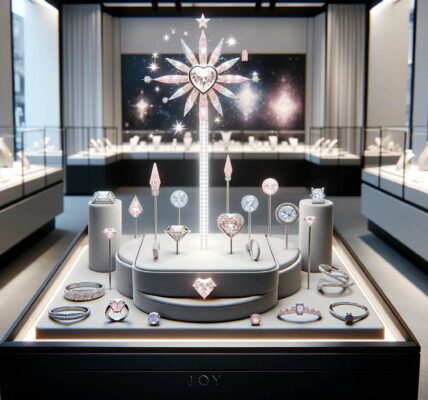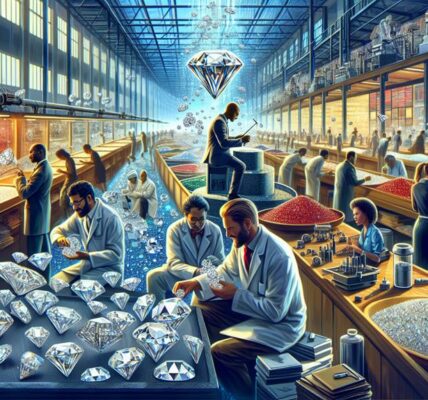Article Contents
TL;DR
Lab-grown diamonds are challenging the dominance of natural diamonds in the market, posing questions about authenticity and value.
Diamonds have long been revered as the ultimate luxury item, symbolizing beauty, rarity, and durability. However, the traditional diamond industry is facing a significant shift with the rise of lab-grown diamonds. This blog delves into the history of diamond formation, the emergence of synthetic diamonds, and the implications for the jewelry industry.
The Natural Origins of Diamonds
Diamonds, the epitome of luxury and elegance, have a fascinating origin story deeply rooted in the Earth’s mantle. The formation of these exquisite gems is a testament to the forces of nature that have captivated humanity for centuries.
Formation of Diamonds in Earth’s Mantle
Over a billion years ago, deep within the Earth’s mantle, the magic of diamond formation began. Under immense pressure and heat, carbon atoms arranged themselves into the crystalline structure that defines diamonds. This unique process, occurring over millions of years, resulted in the creation of these precious stones with unparalleled durability and brilliance.
Volcanic Eruptions and Diamond Resurfacing
The journey of diamonds from the depths of the Earth to its surface is a tale of volcanic eruptions and geological upheavals. Through these powerful forces, diamonds were thrust upwards, carried within volcanic rocks, only to be revealed when these eruptions reached the Earth’s surface. The sudden change in temperature solidified the diamonds, preserving them for eternity and setting the stage for their discovery by humans.
Historical Context of Natural Diamonds
Throughout history, natural diamonds have symbolized wealth, power, and love. Their rarity and beauty made them coveted possessions, passed down through generations as heirlooms and tokens of affection. However, the diamond industry has not been without controversy, with issues of exploitation, conflict, and environmental impact tarnishing its glittering facade.
As the allure of natural diamonds persists, a new contender has emerged in the form of lab-grown diamonds. These ethically sourced and sustainable alternatives offer a compelling choice for consumers seeking both beauty and conscience in their jewelry selections.
The debate between natural and synthetic diamonds continues to evolve, challenging the traditional notions of value and authenticity in the diamond industry. As technology advances and consumer preferences shift towards ethical practices, the future of diamonds lies at the intersection of nature and innovation.
The Advent of Lab-Grown Diamonds
Technological innovations have revolutionized the diamond industry, paving the way for the emergence of lab-grown diamonds. These synthetic gems, created through advanced methods like HPHT and CVD, are reshaping the landscape of luxury jewelry.
Technological Innovations in Diamond Synthesis
The traditional belief that diamonds are exclusively formed deep within the Earth’s mantle is being challenged by modern science. With the introduction of innovative techniques, scientists can now replicate the natural diamond formation process in controlled laboratory settings.
High pressure high temperature (HPHT) and chemical vapor deposition (CVD) are two primary methods used for growing diamonds. HPHT mimics the geological conditions under which diamonds are naturally created, while CVD involves depositing carbon atoms onto a substrate to form diamond crystals.
HPHT and CVD Methods of Diamond Growth
HPHT technology subjects carbon to extreme pressure and temperature, inducing diamond crystallization. This process accelerates the formation of diamonds, producing gems with exceptional clarity and purity. On the other hand, CVD utilizes a gas mixture to deposit carbon atoms layer by layer, resulting in high-quality synthetic diamonds.
These cutting-edge methods have enabled scientists to create diamonds that rival their natural counterparts in terms of beauty and durability. The meticulous control over the growth conditions ensures that lab-grown diamonds exhibit desirable characteristics sought after by consumers.
Advancements in Lab-Grown Diamond Quality
Recent advancements in lab-grown diamond technology have led to significant improvements in quality. Synthetic diamonds now boast larger sizes, enhanced clarity, and increased purity levels, making them virtually indistinguishable from natural diamonds to the naked eye.
The rising quality of lab-grown diamonds poses a challenge to the traditional diamond industry, as consumers are presented with a more affordable yet equally stunning alternative to natural gems. The ethical and environmental considerations surrounding lab-grown diamonds further contribute to their appeal among conscious consumers.
As the demand for sustainable and ethical jewelry grows, lab-grown diamonds are positioned to disrupt the market and redefine the standards of luxury. The convergence of technology and craftsmanship in creating these synthetic gems underscores a new era in the diamond industry. As more consumers become conscious of the environmental and social impact of traditional diamond mining, lab-grown diamonds offer a more ethical and sustainable alternative. This shift in consumer behavior is also reflected in the demand for jewelry made by women in diamond district, as more shoppers seek out pieces that are crafted with care and intention. The rise of lab-grown diamonds not only signifies a change in the way we perceive luxury, but also represents a significant step towards a more responsible and inclusive industry.
Challenges Faced by the Diamond Industry
The diamond industry is currently navigating through a myriad of challenges brought about by the emergence of synthetic diamonds, the need for accurate differentiation between natural and lab-grown diamonds, and growing concerns regarding the environmental and ethical implications of diamond mining.
Impact of Synthetic Diamonds on Market Value
Synthetic diamonds have significantly impacted the market value of natural diamonds. With their lower production costs and technological advancements that mimic the qualities of natural diamonds, synthetic diamonds are becoming increasingly popular among consumers. This shift in consumer preference has led to a disruption in the traditional diamond market, posing challenges for industry players.
Detection and Differentiation of Natural vs. Lab-Grown Diamonds
The ability to accurately detect and differentiate between natural and lab-grown diamonds has become a critical issue within the industry. Both types of diamonds share similar chemical compositions, making visual identification challenging. As lab-grown diamonds improve in quality and resemblance to natural diamonds, the industry faces the dilemma of ensuring transparency and authenticity in diamond trading.
Environmental and Ethical Concerns in Diamond Mining
Diamond mining has long been associated with environmental degradation and ethical concerns. The industry’s impact on local ecosystems, communities, and labor practices has raised questions about the sustainability and ethical sourcing of diamonds. As consumer awareness regarding ethical practices grows, industry players are under pressure to address these issues and adopt more sustainable mining practices.
The Debate: Natural vs. Lab-Grown Diamonds
In the ongoing debate surrounding diamonds, the comparison between natural and lab-grown diamonds has become a focal point. Consumers, industry players, and experts all weigh in on the advantages and disadvantages of each type, shaping the future of the diamond industry.
Consumer Preferences and Perceptions
Consumer preferences play a crucial role in the diamond market. Traditionally, natural diamonds have been revered for their rarity and historical significance. However, the emergence of lab-grown diamonds has introduced a new dimension to consumer choices. With advancements in technology, synthetic diamonds now offer a more affordable alternative without compromising on quality.
Consumers are increasingly considering factors such as ethical sourcing and sustainability when making purchasing decisions. Lab-grown diamonds, being environmentally friendly and ethically produced, are gaining traction among socially conscious buyers. This shift in consumer mindset is reshaping the diamond landscape, challenging the dominance of natural diamonds.
Industry Efforts to Maintain Natural Diamond Demand
Amidst the rise of lab-grown diamonds, the natural diamond industry is making concerted efforts to maintain demand for its products. Industry players are focusing on highlighting the unique allure and timeless appeal of natural diamonds to differentiate them from their synthetic counterparts.
Marketing campaigns emphasizing the authenticity and heritage of natural diamonds aim to preserve their market share. Collaborations with renowned designers and celebrities further enhance the prestige associated with natural diamonds, appealing to luxury consumers seeking exclusivity and tradition.
The Role of Certification and Verification
Certification and verification processes are pivotal in distinguishing between natural and lab-grown diamonds. Industry standards ensure transparency and authenticity, providing consumers with confidence in their diamond purchases.
Organizations like the Gemological Institute of America (GIA) play a crucial role in certifying diamonds based on their origin and characteristics. Through rigorous testing and documentation, consumers can verify the authenticity of natural diamonds and make informed decisions.
As technology advances, the certification process continues to evolve to address the challenges posed by synthetic diamonds. Enhanced verification methods are essential to uphold the integrity of the diamond market and safeguard consumer trust.
Overall, the debate between natural and lab-grown diamonds reflects the evolving preferences and values of consumers in the modern era. Industry responses to these changing dynamics will shape the future of the diamond market, emphasizing the importance of transparency, sustainability, and innovation.
The Future of Diamond Production
As the diamond industry continues to evolve, the future of diamond production is being shaped by technological advancements, changing market trends, and a growing focus on sustainability and ethics. Let’s delve into the key talking points that highlight the direction in which the diamond industry is heading.
Technological Advancements in Diamond Synthesis
One of the most significant developments in the diamond industry is the rise of lab-grown diamonds through technological innovations. These synthetic diamonds are created in controlled environments using advanced processes that mimic the natural formation of diamonds. The ability to produce high-quality diamonds in a laboratory setting has revolutionized the market, offering consumers a more affordable and sustainable alternative to natural diamonds.
Market Trends and Forecast for Lab-Grown Diamonds
The market for lab-grown diamonds is experiencing rapid growth, driven by increasing consumer demand for ethically sourced and environmentally friendly options. As technology continues to improve, lab-grown diamonds are becoming virtually indistinguishable from natural diamonds, challenging traditional perceptions of value and authenticity. Industry experts predict that the market share of lab-grown diamonds will continue to expand, posing a significant disruption to the traditional diamond supply chain. One company leading the way in the lab-grown diamond market is Lightbox, a subsidiary of De Beers Group. With their affordable pricing and high-quality product, Lightbox’s bold leap into the market has garnered significant attention and is shifting the dynamics of the industry. As more consumers become aware of the benefits of lab-grown diamonds, the demand for these sustainable alternatives is expected to continue growing. The traditional diamond industry will need to adapt to these changes in order to remain competitive in the evolving market.
Sustainability and Ethics in Diamond Industry Practices
With the spotlight on sustainability and ethics, the diamond industry is under pressure to adopt responsible practices throughout the production process. Consumers are increasingly conscious of the environmental and social impact of their purchases, leading to a growing demand for ethically sourced diamonds. Companies are now focusing on transparency, traceability, and ethical sourcing to meet the evolving expectations of consumers and ensure the long-term sustainability of the industry.
Conclusion
As the diamond industry navigates the intersection of technology, market dynamics, and ethical considerations, it is clear that the future of diamond production is undergoing a transformation. The shift towards lab-grown diamonds, driven by technological advancements and changing consumer preferences, signals a new era in the industry. Sustainability and ethics are becoming central pillars of the diamond trade, shaping the way diamonds are produced, marketed, and perceived. The coexistence of natural and synthetic diamonds highlights the industry’s adaptability to changing times and the importance of innovation in meeting the demands of a conscious consumer base.
In conclusion, the diamond industry is undergoing a transformative period with the increasing prevalence of lab-grown diamonds. While the allure of natural diamonds remains strong, the accessibility and ethical appeal of synthetic diamonds are reshaping the market dynamics. As technology continues to advance, the distinction between natural and lab-grown diamonds may blur further, challenging conventional perceptions of value and authenticity.
More About Diamond Production
1: Eternal Echoes: The Resonance of Superdeep Diamonds in Timeless Jewellery
2: Discover the World of Natural Diamonds
3: Are Lab Grown Diamonds Real Diamonds?
4: The Truth About Lab-Grown Diamonds






